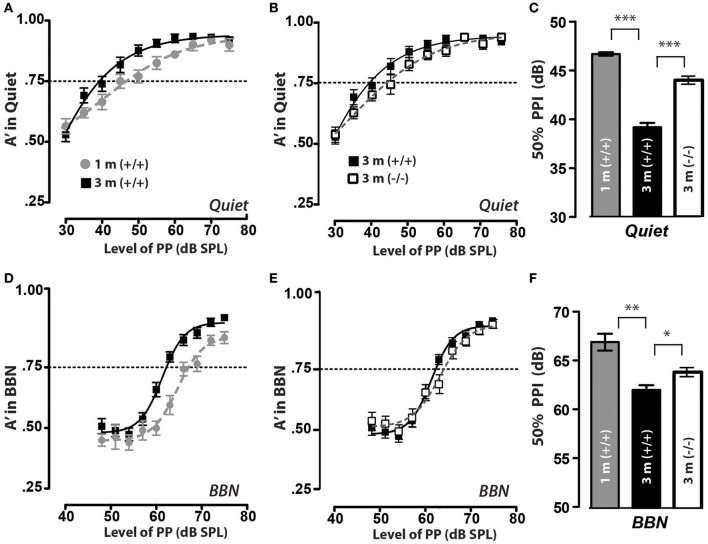Figure 4.
Prepulse inhibition improves during juvenile to adult maturation with the LOC neuropeptide CGRP. (A) In quiet, CGRP (+/+) animals of both ages can inhibit their acoustic startle with a prepulse at 80 dB, and did not inhibit their startle with a prepulse at 30 dB (edges of psychometric function). However, the threshold for inhibiting their startle response 50% of presentations (A′ = 0.75) is higher at 1 month (1 m) and drops by 3 m of age. (B) Similarly, in quiet, CGRP (–/–) animals can inhibit their acoustic startle yet the threshold for inhibiting their startle response 50% of the time (A′ = 0.75) is higher at for CGRP null (–/–) animals when compared to CGRP wildtype control (+/+) animals tested at 3 months of age. (C) Mean PPI thresholds (defined as prepulse level at A′ = 0.75) and SEM values are shown for both CGRP (+/+) solid bars and CGRP null (–/–) animals (open bars), and each group contained 12 mice. There was a significant threshold increase for CGRP (+/+) animals between 1 and 3 m (***p < 0.001). (D,E) When prepulse inhibition of the acoustic startle reflex was tested in 60 dB background noise (BBN), CGRP (+/+) and CGRP (–/–) mice of both ages were able to inhibit their startle reflex when tested with a prepulse of 80 dB, but did not inhibit their startle with a prepulse at 50 dB; yet similar to the quiet condition, the threshold for 1 month animals was higher than for the same animals at 3 m. (F) There was a significant decrease in PPI thresholds in BBN in CGRP (+/+) between 1 and 3 m (**p < 0.01), and a less significant increase in PPI thresholds in CGRP null (–/–) animal's thresholds with maturation (*p < 0.05).

